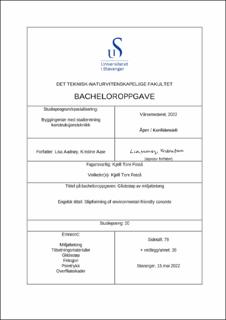| dc.contributor.advisor | Fosså, Kjell Tore | |
| dc.contributor.author | Aadnøy, Lisa | |
| dc.contributor.author | Aase, Kristine | |
| dc.date.accessioned | 2022-07-16T15:51:44Z | |
| dc.date.available | 2022-07-16T15:51:44Z | |
| dc.date.issued | 2022 | |
| dc.identifier | no.uis:inspera:102982611:50803097 | |
| dc.identifier.uri | https://hdl.handle.net/11250/3006056 | |
| dc.description.abstract | Betong er sterkt, bestandig og anvendelig, og regnes som et av verdens mest brukte byggemateriale. Materialet er forbundet med et høyt utslipp av klimagasser, og sementenproduksjonen anslås til å stå for 7-8% av utslippene på verdensbasis. Jordas klima er i forandring som et resultat av økt CO2-utslipp, og det er derfor et høyt fokus på å gjøre betong mer miljøvennlig ved å redusere sementbruken. Miljøvennlig betong regnes som betong der det er gjort tiltak for å redusere klimagassutslippene, hvor hovedfokuset ligger på å erstatte deler av sementen med tilsetningsmaterialer. Pozzolaner som flygeaske og silikastøv er hyppig brukte tilsetningsmaterialer som kan påvirke betongens egenskaper.
Glidestøp er en rask og kostnadseffektiv konstruksjonsmetode som har vært i bruk i flere tiår. Teknikken blir brukt i byggeprosjekter med høye strukturer som for eksempel heissjakter, brutårn og plattformer offshore. Metoden er enkel, men utfordrende, da glidestøp pågår døgnet rundt til ønsket konstruksjonshøyde er oppnådd. Betongen blir støpt ut lagvis i en glideform som løftes med jevne mellomrom. Når glideformen løftes blir betongen utsatt for friksjonskrefter. Blir friksjonskreftene for høye, kan skader i betongoverflaten oppstå.
Denne oppgaven har som mål å undersøke hvordan mer miljøvennlig betong egner seg til bruk i glidestøp. Det blir satt fokus på tilsetningsmaterialene flygeaske og silikastøv og hvilken effekt disse tilfører betongen.
Oppgaven består av en teoridel og et forsøksprogram. Teoridelen tar for seg miljøbetong og glidestøp hver for seg, mens forsøksprogrammet skal gi en indikasjon på hvordan disse fungerer sammen. Det er brukt åtte ulike betongresepter der innholdet av flygeaske varierer fra 15 til 60%. Tre av blandingene er en kombinasjon av flygeaske med 6% silikastøv. Glideriggen ved Universitetet i Stavanger blir brukt for gjennomføring av forsøkene, og aktuelle data blir bearbeidet i Matlab.
Av resultatene kommer det frem at økt andel flygeaske vil forlenge hydratiseringsprosessen og dermed også medføre en forlenget avbindingstid. En lengre avbindingstid vil gi større friksjon mellom glidepanelet og betongen, noe som kan resultere i større risiko for overflateskader. Ingen av betongelementene viser tendenser til skader på overflaten, slik som forventet, noe som kan skyldes at forsøkene ble utført under kontrollerte forhold. | |
| dc.description.abstract | Concrete is strong, durable, and usable, and is considered as one of the world's most widely used building materials. The material is associated with high emissions of greenhouse gases, and cement production is estimated to account for 7-8% of climate emissions worldwide. The earth's climate is changing because of increased CO2 emissions, and there is therefore a high focus on making concrete more environmental-friendly by reducing use of cement. Environmental-friendly concrete is considered as concrete where measures have been taken to reduce climate emissions, where the main focus is on replacing parts of the cement with additive materials. Pozzolans such as Fly Ash and Silica Fume are frequently used additives that can affect the properties of the concrete.
Slipforming is an effective and economical construction method which has been used for decades. The technique is used in construction projects with high structures such as elevator shafts, bridge towers and offshore platforms. The method is simple, but challenging, as slipforming takes place around the clock until the desired construction height is achieved. The concrete is cast in layers in a formwork. The formwork is lifted at regular intervals, and the concrete is therefore exposed to frictional forces. If the frictional forces become too high, damage to the concrete surface can occur.
This thesis aims to investigate how more environmental-friendly concrete is suitable for use in slipforming. The focus is on the additive materials Fly Ash and Silica Fume and what effect these add to the concrete.
The thesis consists of a theory part and an experimental program. The theory part deals with environmental concrete and slipforming separately, while the experimental program will give an indication of how these works together. Eight different concrete recipes have been used, where the content of Fly Ash varies from 15 to 60%. Three of the mixtures are a combination of Fly Ash with 6% Silica Fume. The slipforming rig at the University of Stavanger has been used to carry out the experiments, and current data has been processed in a computer program called Matlab.
The results show that an increased proportion of fly ash will prolong the hydration process and thus also lead to an extended setting time. A longer setting time will give greater friction between the slipform panel and the concrete, which can result in a higher risk of surface damage. None of the concrete elements show tendencies to damage to the surface, which may be due to that the experiments were performed under controlled conditions. | |
| dc.language | nob | |
| dc.publisher | uis | |
| dc.title | Glidestøp av miljøbetong | |
| dc.type | Bachelor thesis | |
